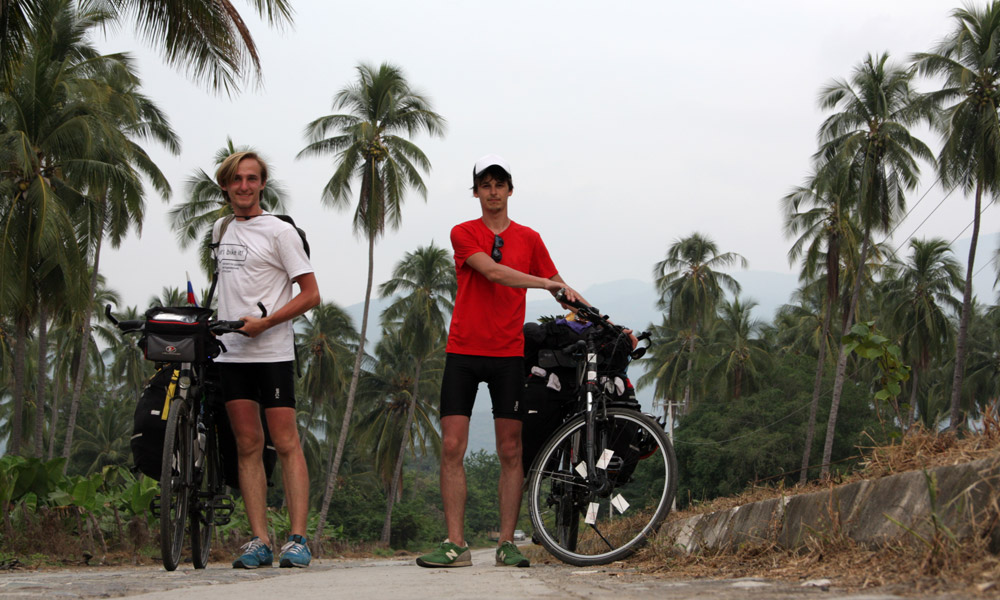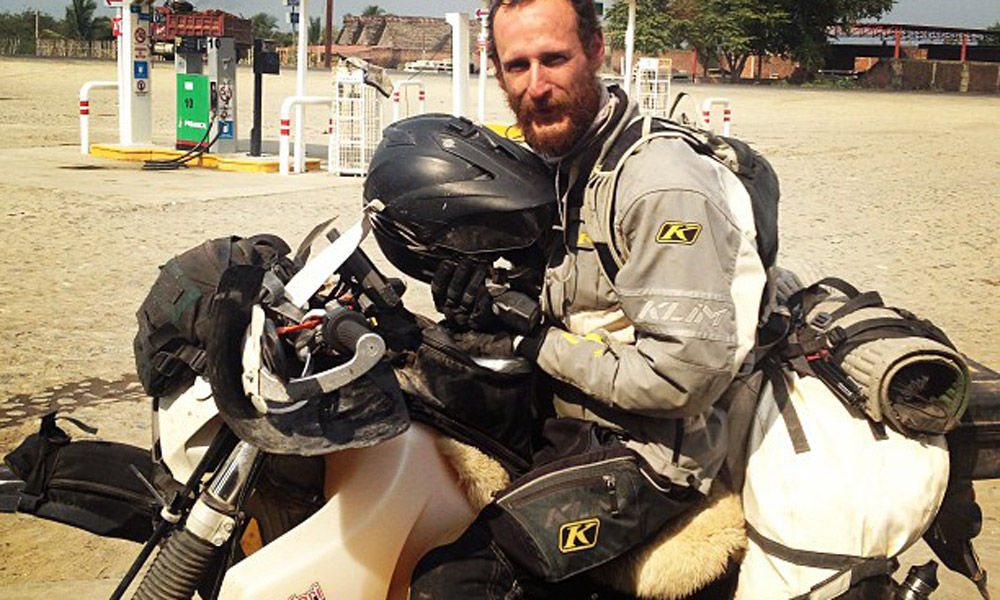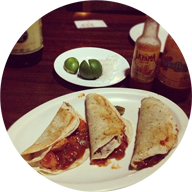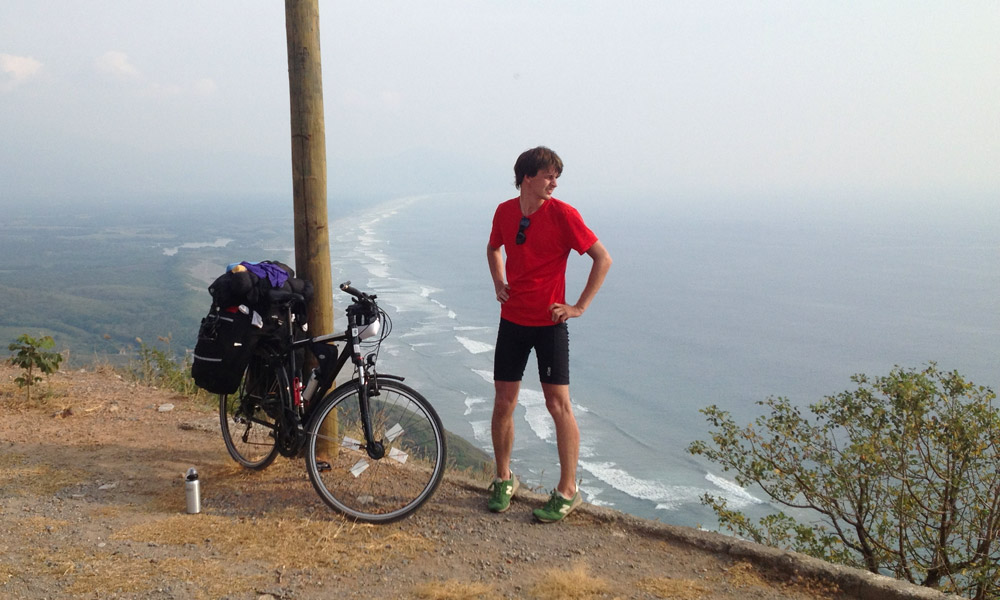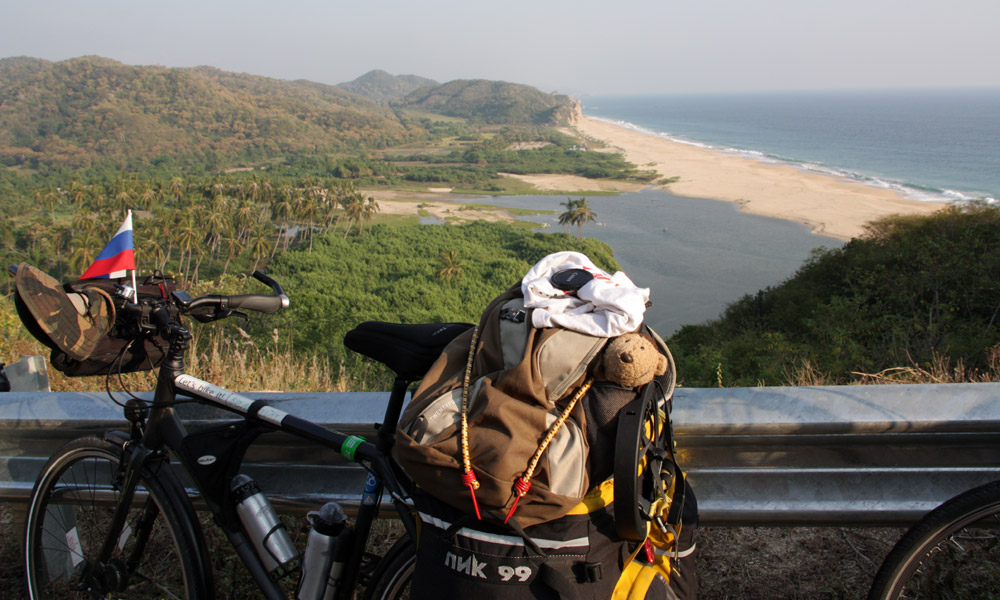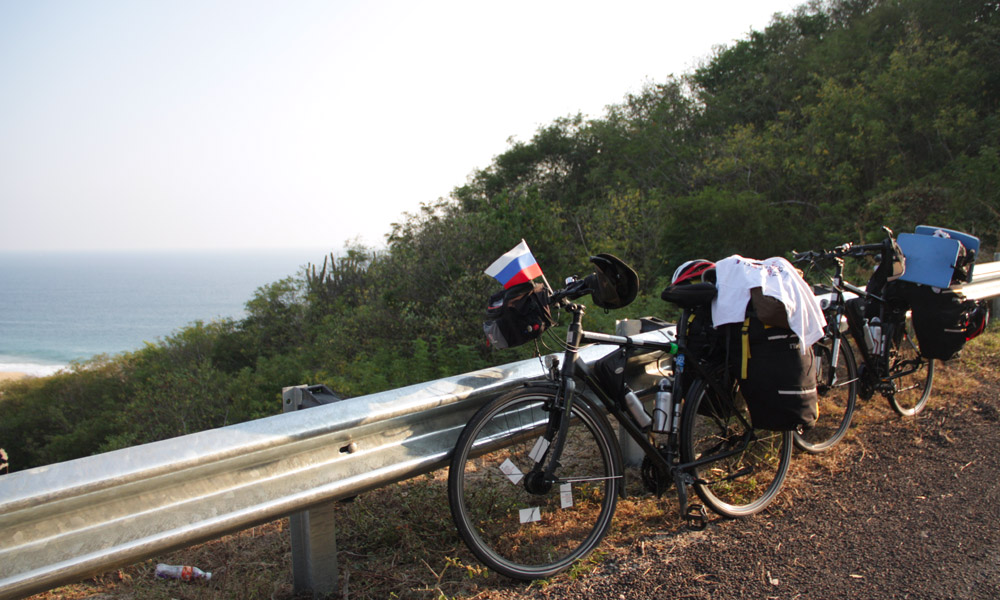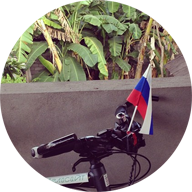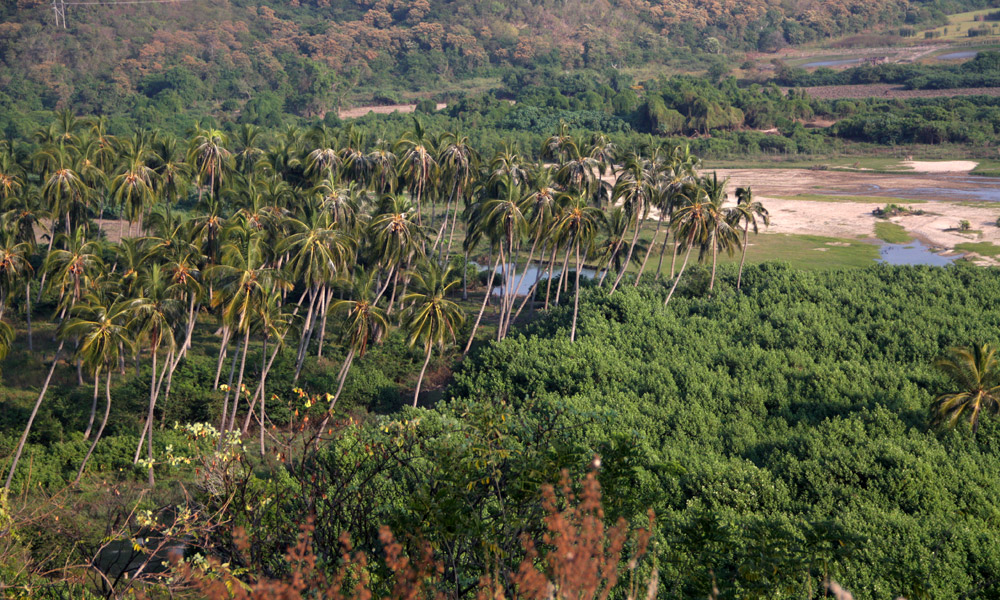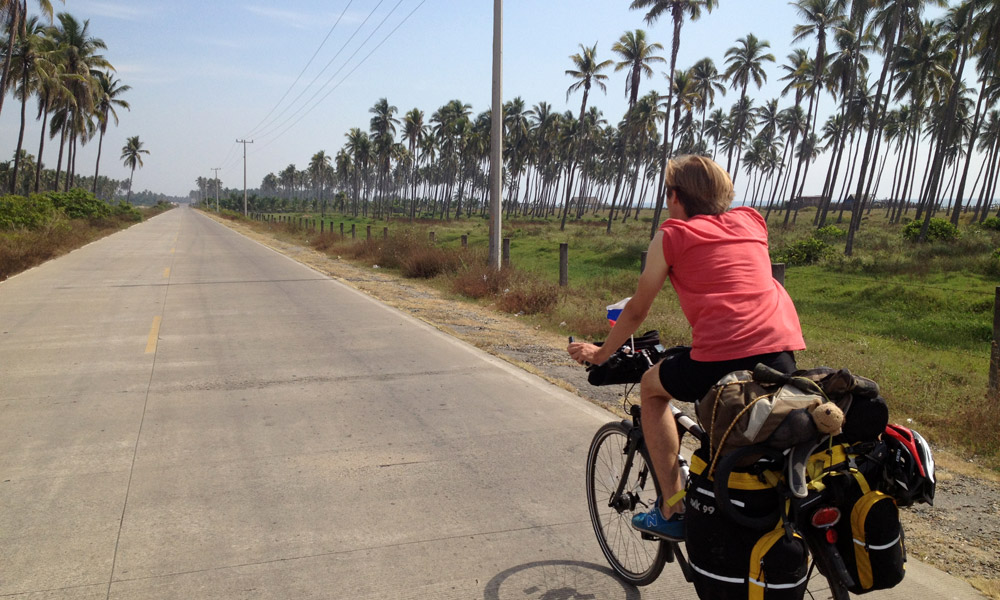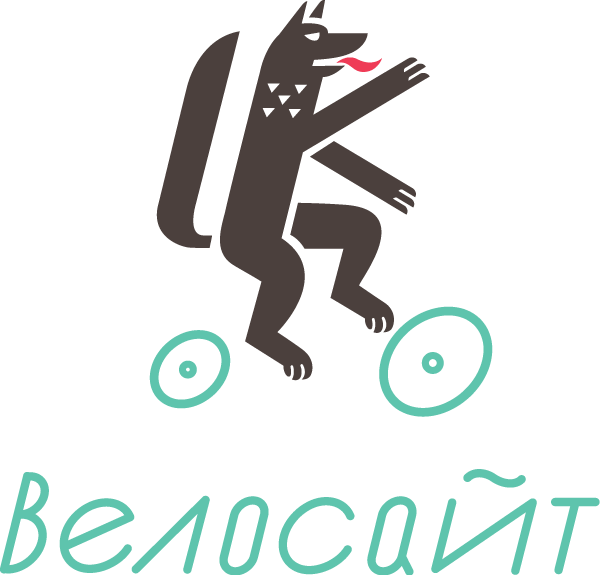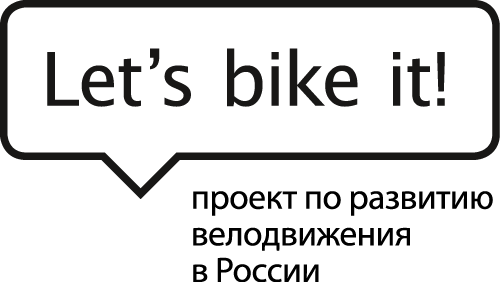Big post about the days we spent away from the big cities, for which we rode 280 km to the “soul of Mexico” — the state of Michoacan.
After cozy Colima, situated near the eponymous volcano, we had to overcome 50-some kilometers before Teсoman, which is located 10 km from the Pacific Ocean.
Day 4.
The way was comfortable. With every passed kilometer we felt the scent of ocean salt in the air more and more, in addition, almost the whole stretch of this road was going downhill. We rolled towards the ocean.
In Tecoman Ivan, the owner of the firm engaged in the installation of satellite equipment, was waiting for us. Actually, the name Ivan is very common in Latin America. As Wikipedia suggested, the fashion for this name came here after the close relations with the Soviet Union during the second half of the twentieth century. We found Ivan by Couchsurfing, saw in his profile on the site, that he had already hosted cycle tourists. He was very hospitable and took us by car to the sea and regaled us at the seaside restaurant where the local cuisine of fresh fish, shrimp and octopus was served. Also he showed us an amusing commercial Video created for the Corona Beer. It was very funny!
After supper we returned to the city and Ivan arranged the use of a room in his relative’s hotel for free. The next few days we had expected a tough road and a few nights out of the cities, so wonderful evening came in very handy. Inspired, we hurried to bed.
Day 5.
In the morning for the first time during our journey we didn’t know where we would be staying overnight... I mean, we couldn’t even imagine. It was about 280 km to a more or less large city — Ciudad Lazaro Cardenas. Throughout this stretch of road the internet maps showed only tiny villages, some even nameless. Without a detailed paper map, we had no idea what route awaited us. We estimated that we could travel that distance in 3 days. As it turned out – we were wrong.
Before we had left Tecoman, we decided to eat some tacos for breakfast. In a half-empty cafe sat a bearded guy with a MacBook. This is how we met Eric, the first traveler in our way. An American, he was traveling alone on a motorcycle from the U.S. to Argentina. He didn’t have any plan, he just zigzagging and stayed for an indefinite period wherever he fancied. He had little luggage: “I have a single T-shirt!” – he jested. We exchanged contacts and went on our way, and after an hour and a half, he caught up with us at the gas station where we stopped to buy water.
There we parted, maybe to meet again someday. He had told us that he was going to stay for a month in Guatemala to learn Spanish. So we had time to catch up with him.
Tacos – is a popular Mexican street food — corn tortilla with meat, herbs, onions and spicy sauce salsa.
We crossed the border of state Colima and entered the Michoacan. After a while the road had change for the worse. Earlier, we had usually travelled along a wide, multilane highway made of smooth asphalt, but now we were on a two-lane road with irregular asphalt. So it was harder to ride, the speed slowed down a bit.
The landscape around us had changed too. The number of hills increased, and the road began to wriggle around, climbing up in spirals and going back down to the ocean. Sometimes we had to climb on foot, pushing up loaded bike, but to go down, of course, was wonderful. The emotions that we experienced during the descent at speeds over 50 km / h had compensated for all the weight-lifting.
Towards the evening, after a few hours of getting used to the new traffic conditions, we reached the Mirador, a viewing point overlooking the valley near the ocean.
The view was incredible. It was worth climbing on foot to this mountain, dripping liters of sweat.
The sun slowly “got down into the ocean” and we still had to find somewhere to stay overnight. The nearest village with a good camping beach, as Ivan recommended us on the eve, was Placito de Morelos. It was very close, along the valley. So we rode that way.
In the village we stopped at a local greengrocery and bought a pineapple, a grapefruit, four apples, four bananas, pears and three carrots for 55 pesos for dinner. That is only about 130 rubles (4 USD). We drove to the beach, but didn’t find other tourists. The local café was empty also. As people said it was off-season. (+30 in the air and it was off-season!) But we were offered to rent a room about 50 meters from the ocean for 150 pesos. We haggled him down a little and agreed on 130.
There was endless beach, sunset and not a soul around – perfect atmosphere for swimming in the ocean. We had supper on the roof of our house. Also in Tekoman we stocked up pasta, canned food and cereals for these days. So it was a great opportunity to test our mobile kitchen equipment and our cooking skills. For the first time in our lives we used the camp stove. This simple food cooked in such conditions was a hundred times more delicious than any restaurant meal. :-) We had taken a pineapple to the beach. We listened to the waves and stared into the starry sky.
Day 6.
For all days of our journey we managed to get up on time just once – at the first day. As usual we left around noon, although we had planned to start at 9 A.M. It was a pity. From noon to four o’clock the sun was most unfriendly and we had to endure it once again.
To escape the heat and in search of dinner we stayed at a wonderful place El Faro.
We really wanted to stay there for the night, but didn’t have time, we had a very small distance. Somewhere after the El Faro our mobiles lost reception...
... but we continued to move slowly through the hills.
We had to choose a place for overnight stop before sundown. Actually, here gets dark quite early and quickly. It was already dusk at 5 p.m., and after half an hour it is quite dark. It is seems unusual and uncomfortable for summer. Riding in the dark in Mexico is very dangerous so the main rule, which shouldn’t be broken — is to reach the destination until 17:30.
Riding in the dark is dangerous so the main rule,
which shouldn’t be broken — is to reach the destination
by sunset.
Because we traveled without map we asked the locals for the distance to the nearest villages. Interesting that here one normally gets an answer to this question in minutes.
— How many kilometers to Marauty?
— 15-20 minutes.
— 15-20 minutes by car?
— By car and by bike too.
No, they clearly speak of cars minutes. We rode across hills for 40-50 minutes. We arrived to our destination not long before sunset. At a cafe near the beach, we asked for permission to the owners to put up a tent on the sand near the cafe. It turned out you have to pay 30 pesos per person for it. It was riskily to be left without our luggage and bicycles at night so we decided not to argue. We agreed on 40 pesos (about 3 USD) for the two of us.
We had no strength left to prepare supper. We set up the tent and found out that we both didn’t fit inside it with the luggage. We had to leave our bags outside, secured them with a bike chain lock and used the pan as an alarm system. By morning the bags were damp. We probably needed to solve our “housing problem” and look for a new tent.
Sound of the ocean sure can be relaxing, but rough sand reminded us about itself all night. We will be smarter next time :-)
Day 7.
We were hardly behind schedule. For two days we traveled only 113 km. We still had to ride 170 km until Ciudad Lazaro Cardenas. It was clear that if we wouldn’t accelerate we could linger for one more day at least, maybe for a few more days.
It still seems that the only way to get drinking-water in Mexico – is to buy a bottle in a shop. There were no water pumps or wells. We both had two 700 ml flasks, one liter aluminum bottle, and usually we took 2 plastic bottles of 1.5 liters into backpacks. It means that our maximum amount of water was 7 liters for two. Usually, during the day we bought more water, so on average we drunk about 10-12 liters per day.
We got used to fairly common villages, once in about 15 km, so we left Maruata with the full flasks. We didn’t know that about 30 km of ups and downs without settlements were ahead. The road skirted the mountains and was zigzagging. It was the most difficult part of our path yet. Maybe because of it, it seemed like forever. We rode half a day to the nearest village. This experience had taught us to stock up on water, without relying on the nearest shops.
We were lucky finding a free tourist map of the state Michoakan, when we had a dinner in one café in a decent village. The names of settlements along the coast and distance were marked on the map. The riding became fun and calm with it, so we could plan a stop for resupply, dinner or overnight.
We stopped for overnight in the village Huahua. Neither beach, nor hotel was there… The saleswoman at the shop advised us to ask resolution (permission ) to put a tent on the hospital grounds behind the fence. But nurse took us to her friend, who offered to rent a room with two big beds and shower on the air for 12 USD. We agreed on 250.
We were advised to put a tent on the hospital grounds behind the fence, but nurse took us to her friend, who offered to rent a room with two beds and shower on the air.
In general, cheap hotels and 3-4 times cheaper rooms for rent in Mexico have the similar condition: in both can live strange insects, both have uncomfortable beds and don’t have hot water. Even so, you can quickly get used to it and it doesn’t seem a hardship. After a day “in the saddle” under the hot sun was great to have a cold shower and to sleep on any surface.
Day 8.
Now we traveled with tourist map, and it showed us distances: about 120 km to town Ciudad Lazaro Cardenas (where we aimed), and 95 km to Playa Azul. It was already the 4-th day without communication and we wanted to get to civilization at any cost. Throughout the way from Tecoman we saw hanging signs on the highway that indicated not to the Lazaro Cardenas, although it further and larger, but the Playa Azul. So we thought it has to be good place.
We had flakes for quick breakfast and left before grilling sun. The daylight was short, so we had to hurry and to sacrifice time on a halt. The road became easier and more often than not was straight. To ride up the hill on the straight is much easier than making it along the arc.
The landscape was changing every day. We had to ride in the shade of trees, then on the wide meadows, then by the ocean, then along the cliffs at high altitude. Coconut palms, banana plantations, corn fields, etc. So it was not boring. Every time was something new. It motivates much, to move forward.
We had tacos for dinner in the village Caleta de Campos. There we met Canadians, traveling by motorcycles. We greeted each other by gestures. The mobile signal appeared and it was the first sign that we were close to big city.
We got to Playa Azul by sundown. Despite the “advertising” signs on the highway and “camping name” – “The Blue Beach” — village and beach itself happened to be worse than we expected. For these days we have passed unnamed beaches, which were much more beautiful than this. The cheapest hotel lacked Internet and hot water, but had enough ants which had finished our flakes :-)
We had to ride 24 km to Lazaro Cardenas, and 120 km to the next city. We would have time to test the endurance, so we decided to have a rest, to finish the site and to do the visa issue. We still have no idea how to get a visa to Costa Rica…
Translated by: Maria Kushakovskaya
comments powered by HyperComments